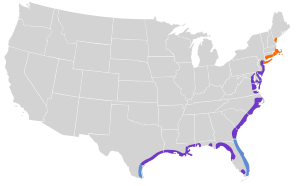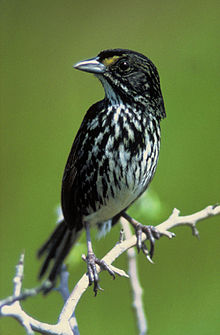Marborda ammodramo
 Marborda ammodramo de Kabo Sable en Nacia Parko Everglades
| ||||||||||||||
| Biologia klasado | ||||||||||||||
| ||||||||||||||
| Ammodramus maritimus (Wilson, 1811) | ||||||||||||||
| Konserva statuso | ||||||||||||||
 | ||||||||||||||
{{{specioj de subdivizio}}}
| ||||||||||||||
|
Ammodramus maritimus mirabilis | ||||||||||||||
Aliaj Vikimediaj projektoj
| ||||||||||||||
La Marborda ammodramo, Ammodramus maritimus, estas malgranda birdo de la grupo de la Amerikaj paseroj kaj genro de Ammodramoj. La 11 specioj de Ammodramus loĝas en marĉoj kaj herbejoj.
Plenkreskuloj havas brunecajn suprajn partojn kun griza en krono kaj nuko, kaj grizeca sablokolora brusto kun malhela strieco; ili havas malhelan vizaĝon kun grizaj vangoj, blanka gorĝo kaj mallonga akrapinta vosto. Tiuj birdoj montras malgrandan flavan strion ĝuste superokule.
Ties reprodukta habitato estas salaj marĉoj de la marbordoj de Atlantiko kaj de la Golfo de Usono el suda Nov-Hampŝiro al suda Teksaso. La nesto estas malferma tasformo kutime konstruata en sala marsĉo en tajdaj kanejoj kaj herbejoj de spartina. La ino demetas 2-5 ovojn.
Nordaj birdoj plej ofte migras suden laŭlonge de la orienta marbordo de Usono.

Ili manĝas surgrunde aŭ en marĉa vegetaĵaro, foje per plukado en koto. Ili manĝas ĉefe insektojn, marajn senvertebrulojn kaj semojn. Ties manĝareoj estas ofte iom for el la areoj elketitaj por nestumado.
Unu el la kelkaj subspecioj de tiu birdo, nome la Malhela marborda ammodramo (A. m. nigrescens), ĵus iĝis formortinta, kaj la subspecio de la Kabo Sable, A. m. mirabilis, estas endanĝerita. Loĝanta en limigita teritorio sed de necerta valideco estas la Skotta marborda ammodramo, (A. m. peninsulae). Tiuj estis iam konsiderataj separataj specioj.
La alvoko ege similas al raspa zumado, simila al la malproksima Ruĝaflugila agelajo.
Literaturo
[redakti | redakti fonton]- BirdLife International (2004). Ammodramus maritimus. Internacia Ruĝa Listo de Endanĝeritaj Specioj, eldono de 2006. IUCN 2006. Elŝutita 11a Majo 2006. Malplej Zorgiga.
Libroj
[redakti | redakti fonton]- Post, W., and J. S. Greenlaw. 1994. Seaside Sparrow (Ammodramus maritimus). In The Birds of North America, No. 127 (A. Poole and F. Gill, Eds.). Philadelphia: The Academy of Natural Sciences; Washington, D.C.: The American Ornithologists’ Union.
Tezoj
[redakti | redakti fonton]- Mayer AL. Ph.D. (1999). Cape Sable seaside sparrow (Ammodramus maritimus mirabilis) habitat and the Everglades: Ecology and conservation. The University of Tennessee, United States, Tennessee.
- McDonald MV. Ph.D. (1986). THE ECOLOGY AND VOCALIZATIONS OF SCOTT'S SEASIDE SPARROWS (AMMODRAMUS MARITIMUS PENINSULAE) (FLORIDA). University of Florida, United States, Florida.
- Post W. Ph.D. (1972). THE SOCIAL ORGANIZATION AND BEHAVIOR OF THE SEASIDE SPARROW AS AN ADAPTIVE RESPONSE TO DIFFERING ENVIRONMENTAL CONDITIONS. North Carolina State University, United States, North Carolina.
- Waddington J. Ph.D. (2000). Microgeographic population structure of the seaside sparrow on the Texas Gulf Coast: A microsatellite analysis. University of Houston, United States, Texas.
Artikoloj
[redakti | redakti fonton]- Avise JC. (1992). Molecular Population Structure and the Biogeographic History of a Regional Fauna a Case History with Lessons for Conservation Biology. Oikos. vol 63, no 1. p. 62-76.
- Avise JC & Nelson WS. (1989). Molecular Genetic Relationships of the Extinct Dusky Seaside Sparrow. Science. vol 243, no 4891. p. 646-648.
- Benoit LK & Askins RA. (2002). Relationship between habitat area and the distribution of tidal marsh birds. Wilson Bulletin. vol 114, no 3. p. 314-323.
- Davis SM, Gaiser EE, Loftus WF & Huffman AE. (2005). Southern marl prairies conceptual ecological model. Wetlands. vol 25, no 4. p. 821-831.
- Delany MF, Leenhouts WP, Sauselein B & Kale HW, II. (1981). The 1980 Dusky Seaside Sparrow Ammospiza-Maritima-Nigrescens Survey. Florida Field Naturalist. vol 9, no 4. p. 64-67.
- Erwin RM, Cahoon DR, Prosser DJ, Sanders GM & Hensel P. (2006). Surface elevation dynamics in vegetated Spartina marshes versus unvegetated tidal ponds along the mid-Atlantic coast, USA, with implications to waterbirds. Estuaries & Coasts. vol 29, no 1. p. 96-106.
- Erwin RM, Sanders GM & Prosser DJ. (2004). Changes in lagoonal marsh morphology at selected northeastern Atlantic coast sites of significance to migratory waterbirds. Wetlands. vol 24, no 4. p. 891-903.
- Estes YB. (1992). SO MUCH FOR THE DUSKY SEASIDE SPARROW. Phi Delta Kappan. vol 73, no 5. p. 411-411.
- Fletcher RJ, Jr., Dhundale JA & Dean TF. (2000). Estimating non-breeding season bird abundance in prairies: A comparison of two survey techniques. Journal of Field Ornithology. vol 71, no 2. p. 321-329.
- Gabrey SW & Afton AD. (2000). Effects of winter marsh burning on abundance and nesting activity of Louisiana seaside sparrows in the Gulf Coast Chenier Plain. Wilson Bulletin. vol 112, no 3. p. 365-372.
- Gabrey SW & Afton AD. (2004). Composition of breeding bird communities in Gulf Coast Chenier Plain marshes: Effects of winter burning. Southeastern Naturalist. vol 3, no 1. p. 173-185.
- Gabrey SW, Afton AD & Wilson BC. (2001). Effects of structural marsh management and winter burning on plant and bird communities during summer in the Gulf Coast Chenier Plain. Wildlife Society Bulletin. vol 29, no 1. p. 218-231.
- Greenlaw JS & Post W. (1985). Evolution of Monogamy in Seaside Sparrows Ammodramus-Maritimus Tests of Hypotheses. Animal Behaviour. vol 33, no 2. p. 373-383.
- Hill CE & Post W. (2005). Extra-pair paternity in seaside sparrows. Journal of Field Ornithology. vol 76, no 2. p. 119-126.
- Holder GL, Johnson MK & Baker JL. (1980). Cattle Grazing and Management of Dusky Seaside Sparrow Ammospiza-Maritima-Nigrescens Habitat. Wildlife Society Bulletin. vol 8, no 2. p. 105-117.
- James FC. (1980). MISCEGENATION IN THE DUSKY SEASIDE SPARROW. Bioscience. vol 30, no 12. p. 800-801.
- Jenkins CN, Powell RD, Bass OL & Pimm SL. (2003). Demonstrating the destruction of the habitat of the Cape Sable seaside sparrow (Ammodramus maritimus mirabilis). Animal Conservation. vol 6, p. 29-38.
- Jenkins CN, Powell RD, Bass OL, Jr. & Pimm SL. (2003). Why sparrow distributions do not match model predictions. Animal Conservation. vol 6, no 1. p. 39-46.
- Leenhouts WP & Baker JL. (1982). Vegetation Dynamics in Dusky Seaside Sparrow Ammospiza-Maritima-Nigrescens Habitat on Merritt Island National Wildlife Refuge Florida USA. Wildlife Society Bulletin. vol 10, no 2. p. 127-132.
- Lockwood JL, Fenn KH, Caudill JM, Okines D, Bass OL, Duncan JR & Pimm SL. (2001). The implications of Cape Sable seaside sparrow demography for Everglades restoration. Animal Conservation. vol 4, p. 275-281.
- Lockwood JL, Fenn KH, Curnutt JL, Rosenthal D, Balent KL & Mayer AL. (1997). Life history of the endangered Cape Sable Seaside Sparrow. Wilson Bulletin. vol 109, no 4. p. 720-731.
- Marshall RM & Reinert SE. (1990). Breeding Ecology of Seaside Sparrows in a Massachusetts USA Salt Marsh. Wilson Bulletin. vol 102, no 3. p. 501-513.
- McDonald MV. (1989). FUNCTION OF SONG IN SCOTTS SEASIDE SPARROW, AMMODRAMUS-MARITIMUS-PENINSULAE. Animal Behaviour. vol 38, p. 468-485.
- McDonald MV & Post W. (1982). TERRITORIAL BEHAVIOR AND SPACING OF SCOTTS SEASIDE SPARROW - AMMOSPIZA-MARITIMA-PENINSULAE. Bird Behaviour. vol 4, no 1. p. 52-52.
- Nelson WS, Dean T & Avise JC. (2000). Matrilineal history of the endangered Cape Sable seaside sparrow inferred from mitochondrial DNA polymorphism. Molecular Ecology. vol 9, no 6. p. 809-813.
- Nott MP & Deangelis D. (1997). Modeling the effects of hydrological regimes on the distribution and breeding success of the Cape Sable seaside sparrow in the Florida Everglades. Bulletin of the Ecological Society of America. vol 78, no 4 SUPPL.
- Phillips SM & Einem GE. (2003). Seaside sparrows, Ammodramus maritimus, breeding in the Rio Grande Delta, southern Texas. Southwestern Naturalist. vol 48, no 3. p. 465-467.
- Post W. (1974). Functional Analysis of Space Related Behavior in the Seaside Sparrow. Ecology. vol 55, no 3. p. 564-575.
- Post W. (1981). THE INFLUENCE OF RICE RATS ORYZOMYS-PALUSTRIS ON THE HABITAT USE OF THE SEASIDE SPARROW AMMOSPIZA-MARITIMA. Behavioral Ecology and Sociobiology. vol 9, no 1. p. 35-40.
- Post W & Brown MM. (1971). Seaside Sparrow Hits a Television Tower near Raleigh North-Carolina. Wilson Bulletin. vol 83, no 1. p. 102-103.
- Post W & Greenlaw JS. (1975). Seaside Sparrow Displays Their Function in Social Organization and Habitat. Auk. vol 92, no 3. p. 461-492.
- Post W & Greenlaw JS. (1989). Metal Barriers Protect near-Ground Nest from Predators. Journal of Field Ornithology. vol 60, no 1. p. 102-103.
- Post W & Greenlaw JS. (2000). The present and future of the Cape Sable Seaside Sparrow. Florida Field Naturalist. vol 28, no 3. p. 93-110.
- Post W & Greenlaw JS. (2006). Nestling diets of coexisting salt marsh sparrows: Opportunism in a food-rich environment. Estuaries & Coasts. vol 29, no 5. p. 765-775.
- Rakestraw JL & Baker JL. (1981). Dusky Seaside Sparrow Ammospiza-Maritima-Nigrescens Feeds Red-Winged Blackbird Agelaius-Phoeniceus Fledglings. Wilson Bulletin. vol 93, no 4. p. 540-540.
- Sharp B. (1969). Conservation of the Dusky Seaside Sparrow on Merritt Island Florida. Biological Conservation. vol 1, no 2. p. 175-176.
- Sharp B. (1969). Lets Save the Dusky Seaside Sparrow Ammospiza-Nigrescens. Florida Naturalist. vol 42, no 2. p. 68-70.
- Sharp B. (1970). A Population Estimate of the Dusky Seaside Sparrow. Wilson Bulletin. vol 82, no 2. p. 158-166.
- Sykes PWJ. (1980). Decline and Disappearance of the Dusky Seaside Sparrow Ammospiza-Maritima-Nigrescens from Merritt Island Florida USA. American Birds. vol 34, no 5. p. 728-737.
- Zink RM & Kale HW. (1995). Conservation genetics of the extinct dusky seaside sparrow Ammodramus maritimus nigrescens. Biological Conservation. vol 74, no 1. p. 69-71.
Eksteraj ligiloj
[redakti | redakti fonton]- Filmetoj de Marborda ammodramo ĉe Internet Bird Collection
- Poŝtmarkoj (de Usono) kun teritoria mapo
- Fotaro de Marborda ammodramo VIREO
- Birdosono de Malhela marborda ammodramo Arkivigite je 2012-10-08 per la retarkivo Wayback Machine
- Birdosono de Marborda ammodramo de la Kabo Sable Arkivigite je 2012-10-08 per la retarkivo Wayback Machine
- Ecological and Genetic Diversity in the Seaside Sparrow, Ekologia kaj Genetika Diverseco ĉe la Marborda ammodramo Arkivigite je 2016-03-04 per la retarkivo Wayback Machine (pdf, 0,95 Mb)
- Marborda ammodramo Arkivigite je 2011-07-14 per la retarkivo Wayback Machine (pdf, 48 Kb)
| ||||||||||||||||||




